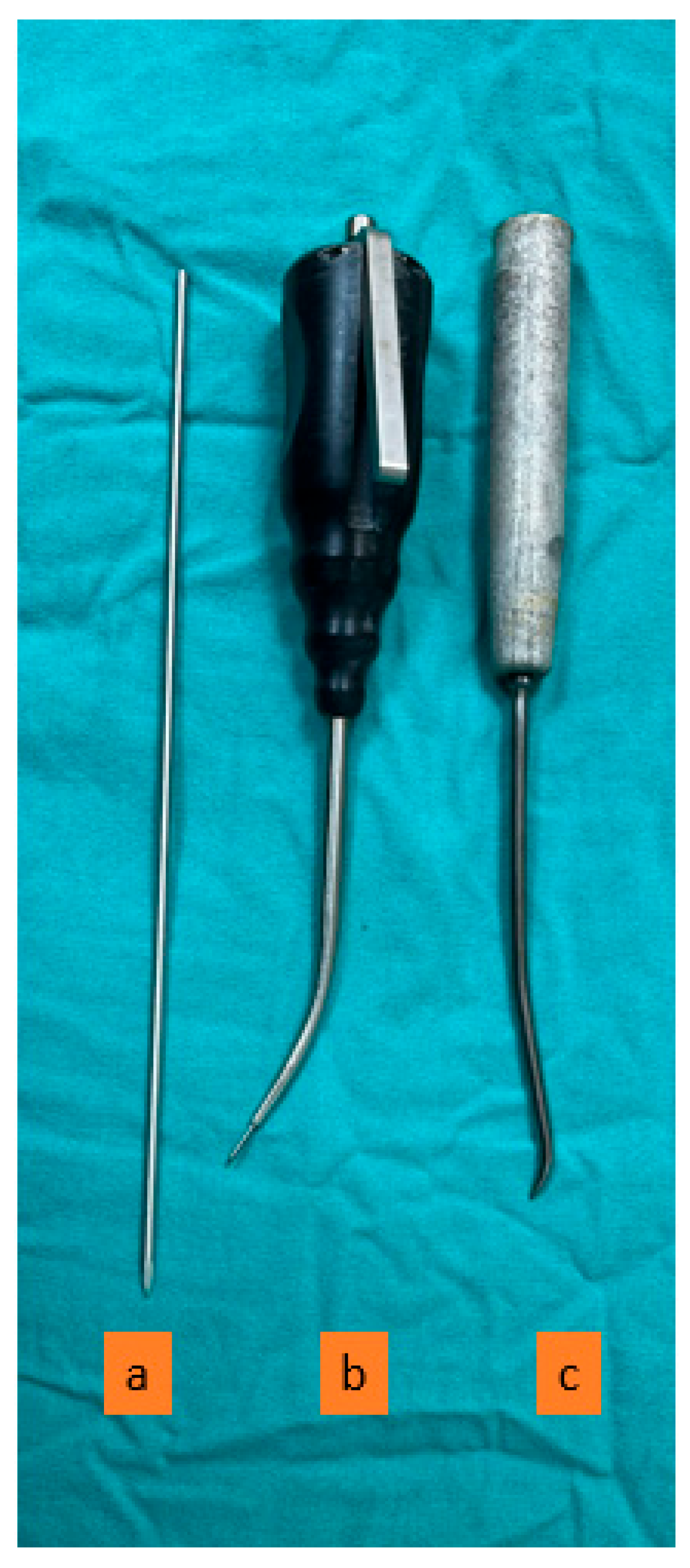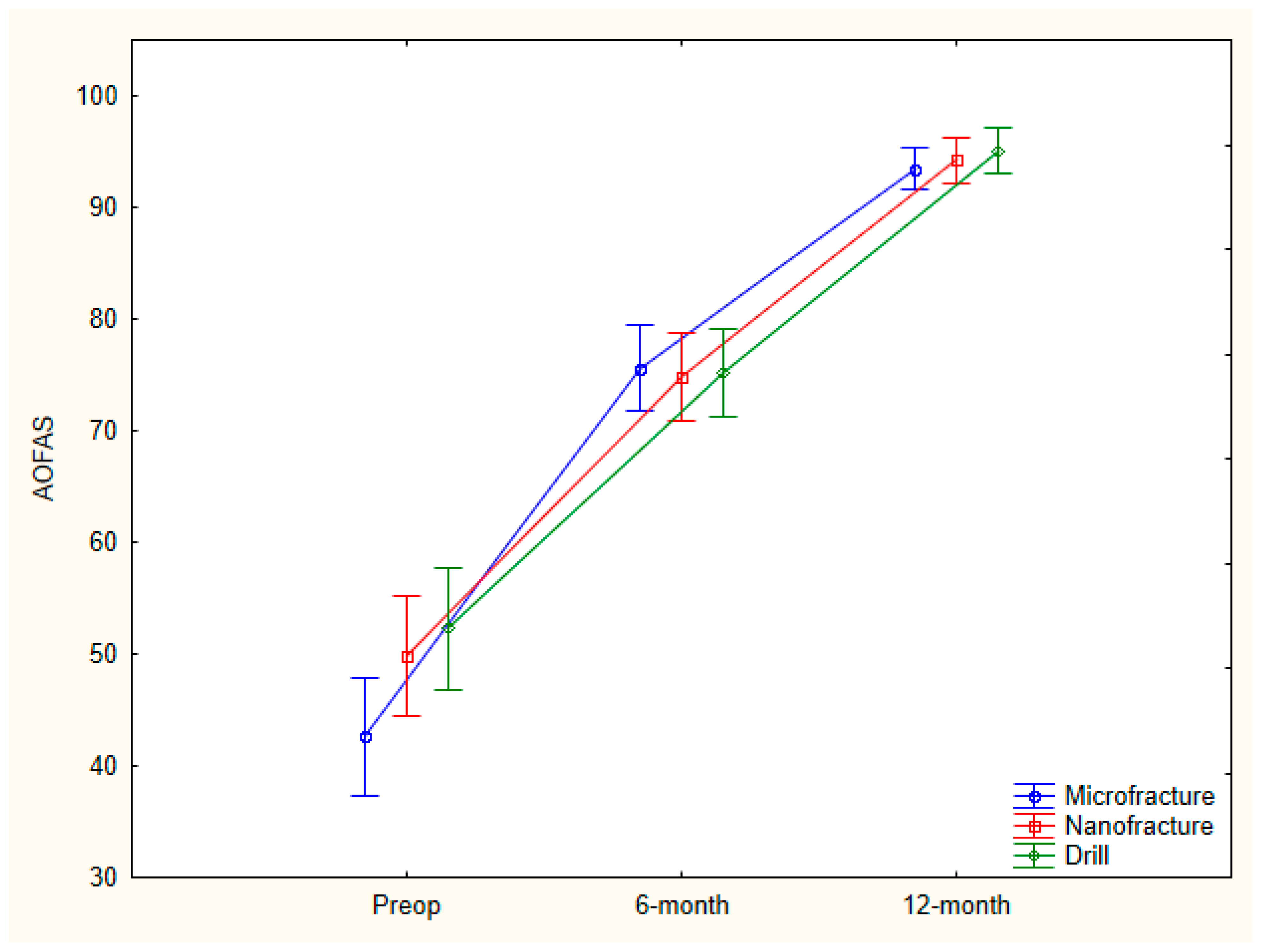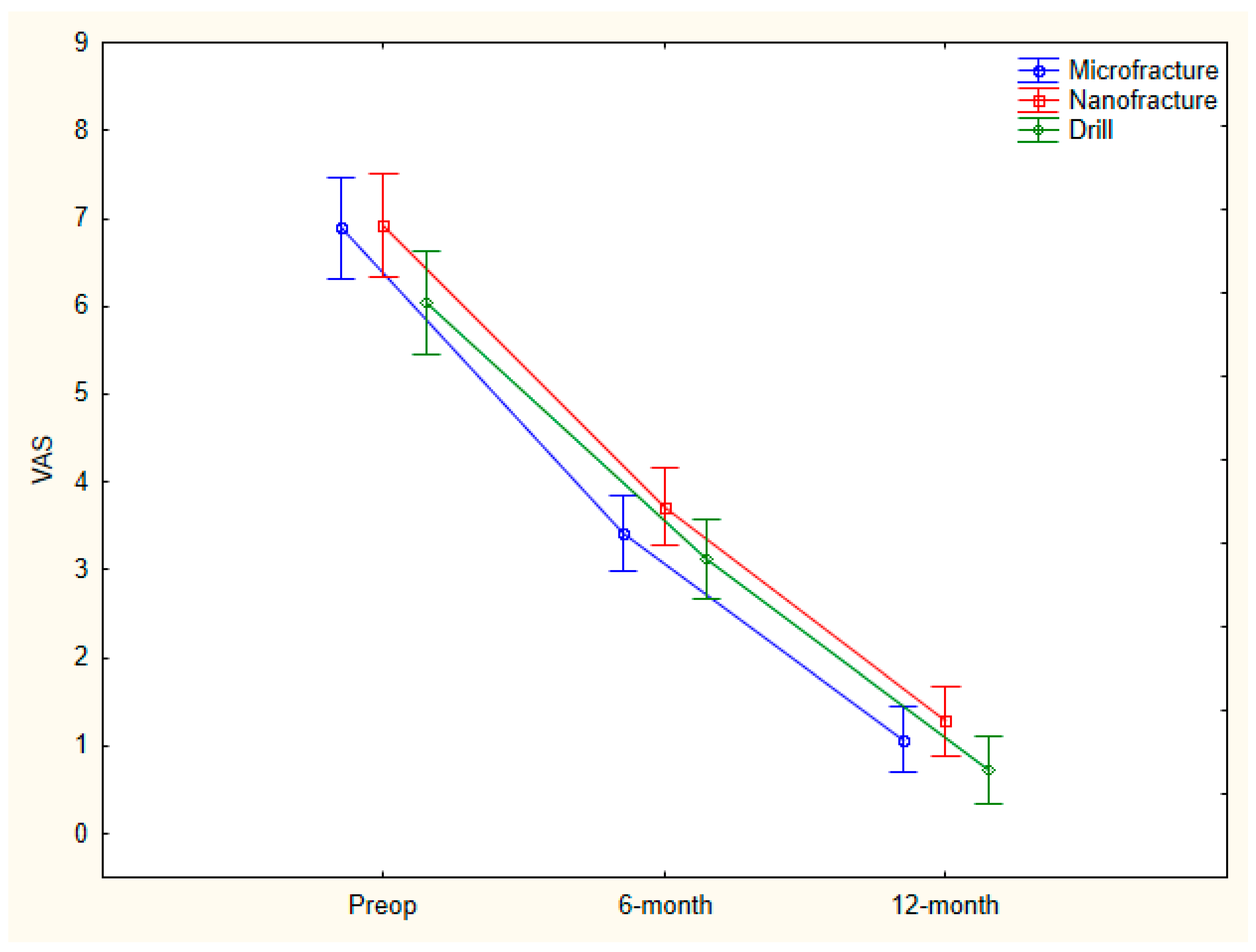Patient-Reported Outcomes of Microfracture, Nanofracture, and K-Wire Drilling in Talus Osteochondral Lesions
Abstract
1. Introduction
2. Materials and Methods
Statistical Analysis
3. Results
4. Discussion
5. Conclusions
Author Contributions
Funding
Institutional Review Board Statement
Informed Consent Statement
Data Availability Statement
Conflicts of Interest
Abbreviations
| AOFAS | American Orthopedic Foot & Ankle Society score |
| VAS | Visual analogue scale score |
| AAS | Ankle arthritis score |
| BMI | Body mass index |
| CT | Computed tomography |
| K | Kirschner wire |
References
- Ramponi, L.; Yasui, Y.; Murawski, C.D.; Ferkel, R.D.; DiGiovanni, C.W.; Kerkhoffs, G.M.M.J.; Calder, J.D.F.; Takao, M.; Vannini, F.; Choi, W.J.; et al. Lesion Size Is a Predictor of Clinical Outcomes After Bone Marrow Stimulation for Osteochondral Lesions of the Talus: A Systematic Review. Am. J. Sports Med. 2017, 45, 1698–1705. [Google Scholar] [CrossRef]
- Yoshimura, I.; Kanazawa, K.; Takeyama, A.; Angthong, C.; Ida, T.; Hagio, T.; Hanada, H.; Naito, M. Arthroscopic bone marrow stimulation techniques for osteochondral lesions of the talus: Prognostic factors for small lesions. Am. J. Sports Med. 2013, 41, 528–534. [Google Scholar] [CrossRef]
- Warren, J.; Brockett, C.; Canden, A.; Farndon, M.A. How Does Surgical Technique Affect Fluid Permeability? A Laboratory Study Comparing Nanofracture, Microfracture and Fine Wire Drilling Approaches. Foot Ankle Orthop. 2022, 7, 2473011421S00995. [Google Scholar] [CrossRef]
- Tahta, M.; Akkaya, M.; Gursoy, S.; Isik, C.; Bozkurt, M. Arthroscopic treatment of osteochondral lesions of the talus: Nanofracture versus hyaluronic acid-based cell-free scaffold with concentration of autologous bone marrow aspirate. J. Orthop. Surg. 2017, 25, 2309499017717870. [Google Scholar] [CrossRef]
- Cheng, X.; Su, T.; Li, J.; Parekh, S.G.; Hu, Y.; Jiao, C.; Guo, Q.; Li, N.; Jiang, D. Effect of Cigarette Smoking on Postoperative Outcomes After Arthroscopic Bone Marrow Stimulation for Osteochondral Lesions of the Talus. Foot Ankle Int. 2024, 45, 862–869. [Google Scholar] [CrossRef]
- Rikken, Q.G.H.; Dahmen, J.; Stufkens, S.A.S.; Kerkhoffs, G.M.M.J. Satisfactory long-term clinical outcomes after bone marrow stimulation of osteochondral lesions of the talus. Knee Surg. Sports Traumatol. Arthrosc. 2021, 29, 3525–3533. [Google Scholar] [CrossRef]
- Chen, H.; Sun, J.; Hoemann, C.D.; Lascau-Coman, V.; Ouyang, W.; McKee, M.D.; Shive, M.S.; Buschmann, M.D. Drilling and microfracture lead to different bone structure and necrosis during bone-marrow stimulation for cartilage repair. J. Orthop. Res. 2009, 27, 1432–1438. [Google Scholar] [CrossRef]
- Meyer, L.E.; Danilkowicz, R.M.; Hinton, Z.W.; Crook, B.S.; Abar, B.; Allen, N.B.; Negus, M.; Hurley, E.T.; Toth, A.P.; Amendola, A.; et al. Microdrilling Resulted in Less Subchondral Bone Destruction Than a Traditional Microfracture Awl for Articular Cartilage Defect Bone Marrow Stimulation. Arthrosc. Sports Med. Rehabil. 2023, 5, 100786. [Google Scholar] [CrossRef]
- Park, H.W.; Lee, K.B. Comparison of chondral versus osteochondral lesions of the talus after arthroscopic microfracture. Knee Surg. Sports Traumatol. Arthrosc. 2015, 23, 860–867. [Google Scholar] [CrossRef]
- Choi, J.I.; Lee, K.B. Comparison of clinical outcomes between arthroscopic subchondral drilling and microfracture for osteochondral lesions of the talus. Knee Surg. Sports Traumatol. Arthrosc. 2016, 24, 2140–2147. [Google Scholar] [CrossRef]
- Kraeutler, M.J.; Aliberti, G.M.; Scillia, A.J.; McCarty, E.C.; Mulcahey, M.K. Microfracture Versus Drilling of Articular Cartilage Defects: A Systematic Review of the Basic Science Evidence. Orthop. J. Sports Med. 2020, 8, 2325967120945313. [Google Scholar] [CrossRef]
- Gianakos, A.L.; Yasui, Y.; Fraser, E.J.; Ross, K.A.; Prado, M.P.; Fortier, L.A.; Kennedy, J.G. The Effect of Different Bone Marrow Stimulation Techniques on Human Talar Subchondral Bone: A Micro-Computed Tomography Evaluation. Arthroscopy 2016, 32, 2110–2117. [Google Scholar] [CrossRef]
- Benthien, J.P.; Behrens, P. Reviewing subchondral cartilage surgery: Considerations for standardised and outcome predictable cartilage remodelling: A technical note. Int. Orthop. 2013, 37, 2139–2145. [Google Scholar] [CrossRef] [PubMed]
- Murawski, C.D.; Foo, L.F.; Kennedy, J.G. A Review of Arthroscopic Bone Marrow Stimulation Techniques of the Talus: The Good, the Bad, and the Causes for Concern. Cartilage 2010, 1, 137–144. [Google Scholar] [CrossRef]
- Kimball, J.S.; Ferkel, R.D.; Ferkel, E.I. Regeneration: Bone-Marrow Stimulation of the Talus-Limits and Goals. Foot Ankle Clin. 2024, 29, 281–290. [Google Scholar] [CrossRef]
- Steadman, J.R.; Miller, B.S.; Karas, S.G.; Schlegel, T.F.; Briggs, K.K.; Hawkins, R.J. The microfracture technique in the treatment of full-thickness chondral lesions of the knee in National Football League players. J. Knee Surg. 2003, 16, 83–86. [Google Scholar] [PubMed]
- Becher, C.; Driessen, A.; Thermann, H. Die Technik der Mikrofrakturierung zur operativen Therapie von Knorpelläsionen am Talus [Microfracture technique for the treatment of articular cartilage lesions of the talus]. Orthopade 2008, 37, 196–203. [Google Scholar] [CrossRef]
- Biehl, C.; Fritzsche, C.; Walter, N.; Biehl, L.; El Khassawna, T.; Heiss, C.; Rupp, M. Midterm Outcomes and Surgical Approaches for Osteochondral Lesions of the Talus. Foot Ankle Orthop. 2025, 10, 24730114251329378. [Google Scholar] [CrossRef]
- Warren, J.; Canden, A.; Farndon, M.; Brockett, C. μCT analysıs and 3D modellıng of comparatıve fluıd permeabılıty of human talı followıng three dıfferent clınıcal procedures: Nanofracture, mıcrofracture, and fıne wıre drıllıng. Orthop. Procs. 2023, 105 (Suppl. S16), 32. [Google Scholar] [CrossRef]
- Walsh, W.; Bertollo, N.; Schaffner, D.; Christou, C.; Oliver, R.; Hale, D. Bone marrow access ın cartılage repaır: Comparıson of mıcrofracture, nanofracture, k-wıre, and drıll ın the adult ovıne model. Orthop. Procs. 2016, 98 (Suppl. S10), 123. [Google Scholar]
- Chen, H.; Hoemann, C.D.; Sun, J.; Chevrier, A.; McKee, M.D.; Shive, M.S.; Hurtig, M.; Buschmann, M.D. Depth of subchondral perforation influences the outcome of bone marrow stimulation cartilage repair. J. Orthop. Res. 2011, 29, 1178–1184. [Google Scholar] [CrossRef]
- Zedde, P.; Cudoni, S.; Giachetti, G.; Manunta, M.L.; Masala, G.; Brunetti, A.; Manunta, A.F. Subchondral bone remodeling: Comparing nanofracture with microfracture. An ovine in vivo study. Joints 2016, 4, 87–93. [Google Scholar] [CrossRef] [PubMed]
- Kasman, U.O.; Korkmaz, Ö. Comparison of Arthroscopic Microfracture and Retrograde Subchondral Drilling in the Treatment of Osteochondral Lesions of Talus. Acta Chir. Orthop. Traumatol. Cech. 2024, 91, 234–238. [Google Scholar] [CrossRef] [PubMed]
- Polat, G.; Erşen, A.; Erdil, M.E.; Kızılkurt, T.; Kılıçoğlu, Ö.; Aşık, M. Long-term results of microfracture in the treatment of talus osteochondral lesions. Knee Surg. Sports Traumatol. Arthrosc. 2016, 24, 1299–1303. [Google Scholar] [CrossRef] [PubMed]




| Microfracture (n: 27) | Nanofracture (n: 25) | Drilling (n: 25) | p | |||||
|---|---|---|---|---|---|---|---|---|
| Age | Mean ± SD | 45.52 ± 10.8 | 39.02 ± 11.11 | 42.44 ± 11.92 | 0.121 * | |||
| Gender | Male | 13 | 48.15% | 13 | 52.00% | 14 | 56.00% | 0.852 † |
| Female | 14 | 51.85% | 12 | 48.00% | 11 | 44.00% | ||
| Lesion side | Right | 12 | 44.44% | 12 | 48.00% | 12 | 48.00% | 0.956 † |
| Left | 15 | 55.56% | 13 | 52.00% | 13 | 52.00% | ||
| Dominant extremity | Right | 19 | 70.37% | 16 | 64.00% | 15 | 60.00% | 0.731 † |
| Left | 8 | 29.63% | 9 | 36.00% | 10 | 40.00% | ||
| BMI | Mean ± SD | 29.7 ± 4.22 | 29.08 ± 4.63 | 29.47 ± 4.66 | 0.881 * | |||
| Smoking | − | 15 | 55.56% | 16 | 64.00% | 16 | 64.00% | 0.769 † |
| + | 12 | 44.44% | 9 | 36.00% | 9 | 36.00% | ||
| Smoking (package/day/year) | Mean ± SD | 14.5 ± 7.94 | 11.33 ± 8.05 | 7.89 ± 4.17 | 0.124 * | |||
| Symptom duration (months) | Mean ± SD | 18.22 ± 8.15 | 18.24 ± 13.96 | 24.68 ± 23.77 | 0.336 † | |||
| Median (IQR) | 16 (12–24) | 12 (10.5–21) | 15 (12–35.5) | |||||
| Microfracture (n: 27) | Nanofracture (n: 25) | Drilling (n: 25) | p * | ||||
|---|---|---|---|---|---|---|---|
| AOFAS | preop | 43.63 ± 12.01 | 49.84 ± 14.47 | 52.32 ± 14.48 | 0.053 | ||
| 6th month | 75.63 ± 9.75 | 74.8 ± 11.71 | 75.2 ± 8.08 | 0.956 | |||
| 12th month | 93.48 ± 4.8 | 94.24 ± 5.56 | 95.08 ± 4.84 | 0.528 | |||
| p ‡ | 0.0001 | 0.0001 | 0.0001 | ||||
| VAS | preop | 6.89 ± 1.34 | 6.92 ± 1.63 | 6.04 ± 1.51 | 0.066 | ||
| 6th month | 3.41 ± 1.01 | 3.72 ± 1.37 | 3.12 ± 0.97 | 0.178 | |||
| 12th month | 1.07 ± 0.96 | 1.28 ± 1.28 | 0.72 ± 0.54 | 0.127 | |||
| p ‡ | 0.0001 | 0.0001 | 0.0001 | ||||
| Newman–Keuls Multiple Comparison Test | AOFAS | VAS | |||||
| Microfracture | Nanofracture | Drilling | Microfracture | Nanofracture | Drilling | ||
| preop/6th month | 0.0001 | 0.0001 | 0.0001 | 0.0001 | 0.0001 | 0.0001 | |
| preop/12th month | 0.0001 | 0.0001 | 0.0001 | 0.0001 | 0.0001 | 0.0001 | |
| 6th month/12th month | 0.0001 | 0.0001 | 0.0001 | 0.0001 | 0.0001 | 0.0001 | |
| % Change Difference Value | Microfracture (n: 27) | Nanofracture (n: 25) | Drilling (n: 25) | p * | |
|---|---|---|---|---|---|
| AOFAS | preop–6th month | 43.28 ± 15.04 | 33.17 ± 16.13 | 30.86 ± 15.66 | 0.012 |
| preop–12th month | 19.14 ± 9.32 | 20.77 ± 10.2 | 20.91 ± 7.46 | 0.734 | |
| VAS | preop–6th month | 50.56 ± 11.07 | 46.11 ± 15.71 | 47.94 ± 11.44 | 0.458 |
| preop–12th month | 84.97 ± 12.2 | 82.84 ± 16.24 | 88.35 ± 9.15 | 0.316 | |
| Tukey’s Multiple Comparison Test | AOFAS 6th Month Preop | ||||
| Microfracture/Nanofracture | 0.047 | ||||
| Microfracture/Drilling | 0.015 | ||||
| Nanofracture/Drilling | 0.850 | ||||
Disclaimer/Publisher’s Note: The statements, opinions and data contained in all publications are solely those of the individual author(s) and contributor(s) and not of MDPI and/or the editor(s). MDPI and/or the editor(s) disclaim responsibility for any injury to people or property resulting from any ideas, methods, instructions or products referred to in the content. |
© 2025 by the authors. Licensee MDPI, Basel, Switzerland. This article is an open access article distributed under the terms and conditions of the Creative Commons Attribution (CC BY) license (https://creativecommons.org/licenses/by/4.0/).
Share and Cite
Kasapoğlu, A.G.; Arıcan, M.; Tekçe, Y.; Tekçe, G.; Kaban, İ. Patient-Reported Outcomes of Microfracture, Nanofracture, and K-Wire Drilling in Talus Osteochondral Lesions. Diagnostics 2025, 15, 2255. https://doi.org/10.3390/diagnostics15172255
Kasapoğlu AG, Arıcan M, Tekçe Y, Tekçe G, Kaban İ. Patient-Reported Outcomes of Microfracture, Nanofracture, and K-Wire Drilling in Talus Osteochondral Lesions. Diagnostics. 2025; 15(17):2255. https://doi.org/10.3390/diagnostics15172255
Chicago/Turabian StyleKasapoğlu, Ahmet Görkem, Mehmet Arıcan, Yıldıray Tekçe, Giray Tekçe, and İlyas Kaban. 2025. "Patient-Reported Outcomes of Microfracture, Nanofracture, and K-Wire Drilling in Talus Osteochondral Lesions" Diagnostics 15, no. 17: 2255. https://doi.org/10.3390/diagnostics15172255
APA StyleKasapoğlu, A. G., Arıcan, M., Tekçe, Y., Tekçe, G., & Kaban, İ. (2025). Patient-Reported Outcomes of Microfracture, Nanofracture, and K-Wire Drilling in Talus Osteochondral Lesions. Diagnostics, 15(17), 2255. https://doi.org/10.3390/diagnostics15172255






